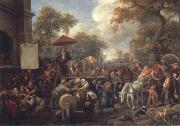Wholesale Oil Painting No Minimum |
|||||||||||
|
|
|||||||||||

|
|||||||||||
|
|
|
||||||||
Jan SteenDutch Baroque Era Painter, ca.1625-1679 Daily life was Jan Steen's main pictorial theme. Many of the genre scenes he portrayed are lively to the point of chaos and lustfulness, even so much that a Jan Steen household, meaning a messy scene, became a Dutch proverb (een huishouden van Jan Steen). Subtle hints in his paintings seem to suggest that Steen meant to warn the viewer rather than invite him to copy this behaviour. Many of Steen's paintings bear references to old Dutch proverbs or literature. He often used members of his family as models. Jan Steen painted also quite a few self-portraits, in which he showed no tendency of vanity. Steen did not shy from other themes: he painted historical, mythological and religious scenes, portraits, still lifes and natural scenes. His portraits of children are famous. He is also well known for his mastery of light and attention to detail, most notably in textiles. Steen was prolific, producing about 800 paintings, of which roughly 350 survive. Steen's work was valued much by contemporaries and as a result he was reasonably well paid for his work. He did not have any students, but his work proved a source of inspiration for many painters. |
||||||||
|
|
||||||||
The Quack
The Quack Painting ID:: 35356 |
mk101
Oil on canvas
76x109cm
mk101 Oil on canvas 76x109cm |
|||||||
|
|
||||||||
|
Franz Anton Maulbertsch (June 7, 1724 -- August 8, 1796) was an Austrian painter and engraver, one of the most renowned exponents of roccoco painting in the German region. Maulbertsch was born in Langenargen and studied in the Academy of Vienna. Through the knowledge of Paul Troger, he was influenced by the Venetian painters Piazzetta and Giovanni Battista Pittoni. He also studied the frescoes by Sebastiano Ricci in the Schönbrunn Palace in Vienna, and frequented Giambattista Tiepolo, who was active in Werzburg starting from 1750. An appreciated frescoer, he received numerous commissions, mostly of ecclesiastical theme. He produced art for churches in Bicske, Kalocsa, Vienna's Michaelerkirche and Piaristenkirche Maria Treu. He also decorated the Porta Coeli in Moravia, the Kromeř Archbishop's Palace and the villa of Halbturn. He also painted a portrait of Narcissus of Jerusalem The quack Date before 1785(1785) Medium oil on panel Dimensions 53 X 56 cm (20.9 X 22 in) ttd |
||||||||
|
|
||||||||
|
Prev Next
|
||||||||
|
|
||||||||
|
Related Paintings to Franz Anton Maulbertsch :. |
||||||||
|
|
||||||||
|
CONTACT US |

